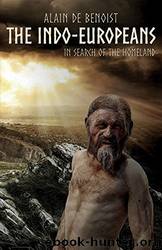The Indo-Europeans: In Search of the Homeland by Alain de Benoist

Author:Alain de Benoist [de Benoist, Alain]
Language: eng
Format: epub
Tags: indo-european, germanic, white race, ötzi, aryans, GRECE, origins, racial, Race
ISBN: 9781910524916
Publisher: Arktos Media Ltd.
Published: 2016-08-18T04:00:00+00:00
Palaeolithic and Mesolithic
If the Globular Amphora and the Corded Ware cultures do not derive from that of the Kurgans, the question then arises of how they were Indo-Europeanised. The most plausible answer is that the Funnel Beaker culture was clearly already IE. Alexander Häusler, who identifies this culture with the homeland, concludes that we must invert the direction of the migration postulated by Gimbutas. From this point of view, it is the Kurgan culture which could have undergone the influence of the Funnel Beaker culture. The Kurgan culture would not have either the importance or extent attributed to it by Gimbutas, and it would only truly begin with the Jamnaya culture, around 3500 BCE. This was already the opinion of Carl Schuchhardt,317 for whom the model of the tumulus grave was born not in the milieu of the steppes, but in Northern Europe. The Corded Ware people were then diffused in three directions: towards the north, in the midst of the megalithic cultures; towards the south; and towards the east. However, there is no clear archaeological evidence of such an influence. All that we can note is that the beginning of the Funnel Beaker culture coincides with Kurgan I in the classification of Gimbutas. The Corded Ware culture is also contemporary with the end of the Jamna cultural horizon, an epoch during which both cultures bordered each other in Galicia and along the Slovenian Carpathians between south Poland and Hungary.
It is clear that no solution to the problem of the homeland can be considered convincing unless it simultaneously explains both the origin of the Kurgan tradition and that of the Corded Ware culture. If the IE cultures of Northern Europe did not derive from those of the steppes, and if the reverse derivation is no longer possible, there is no other alternative than for both of them to come from the same, common culture. Taking the chronology into account, the homeland must then be sought in the Mesolithic, which in Europe lasts from 9000 to 6000 BCE, or even in the Palaeolithic, that is to say around 9000/10000 BCE. This hypothesis is not new. From 1925, Paul Kretschmer318 felt that it was necessary to seek the primitive habitat of the IE in an epoch much more remote than previously thought. In 1932, Herbert Kühn319 proposed to place the homeland in the Upper Palaeolithic, and assimilated the PIE to the Magdalenians. The idea of a PIE community dating back to the Palaeolithic was taken up by Seger in 1936, by Gustav Schwantes in 1958, and by Vladimir Georgiev in the 1960s. Homer L Thomas320 emphasises for his part that, contrary to what we often thought, the transition from the Neolithic to the Palaeolithic was made without breaking the continuity, so there is nothing to stop us from seeking the homeland in the Mesolithic. Tadeus Sulmirski321 affirms that we cannot reject a priori the hypothesis of a Mesolithic origin of the PIE, with some IE language already differentiated at the beginning of the Neolithic.
Download
This site does not store any files on its server. We only index and link to content provided by other sites. Please contact the content providers to delete copyright contents if any and email us, we'll remove relevant links or contents immediately.
| Africa | Americas |
| Arctic & Antarctica | Asia |
| Australia & Oceania | Europe |
| Middle East | Russia |
| United States | World |
| Ancient Civilizations | Military |
| Historical Study & Educational Resources |
The Daily Stoic by Holiday Ryan & Hanselman Stephen(3110)
The Fate of Rome: Climate, Disease, and the End of an Empire (The Princeton History of the Ancient World) by Kyle Harper(2874)
People of the Earth: An Introduction to World Prehistory by Dr. Brian Fagan & Nadia Durrani(2619)
Ancient Worlds by Michael Scott(2493)
Babylon's Ark by Lawrence Anthony(2433)
Foreign Devils on the Silk Road: The Search for the Lost Treasures of Central Asia by Peter Hopkirk(2388)
The Daily Stoic by Ryan Holiday & Stephen Hanselman(2344)
India's Ancient Past by R.S. Sharma(2297)
MOSES THE EGYPTIAN by Jan Assmann(2275)
The Complete Dead Sea Scrolls in English (7th Edition) (Penguin Classics) by Geza Vermes(2135)
Lost Technologies of Ancient Egypt by Christopher Dunn(2111)
The Earth Chronicles Handbook by Zecharia Sitchin(2101)
24 Hours in Ancient Rome by Philip Matyszak(1973)
Alexander the Great by Philip Freeman(1960)
Aztec by Gary Jennings(1879)
The Nine Waves of Creation by Carl Johan Calleman(1784)
Curse Tablets and Binding Spells from the Ancient World by Gager John G.;(1768)
Before Atlantis by Frank Joseph(1740)
Earthmare: The Lost Book of Wars by Cergat(1715)
